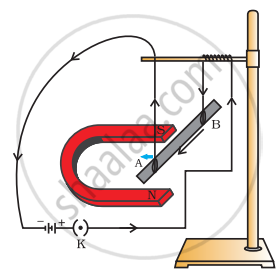Advertisements
Advertisements
प्रश्न
Boojho made an electromagnet by winding 50 turns of wire over an iron screw. Paheli also made an electromagnet by winding 100 turns over a similar iron screw. Which electromagnet will attract more pins? Give reason.
उत्तर
Paheli’s electromagnet will attract more pins as it has more turns of wire on it and thus a stronger electromagnet.
APPEARS IN
संबंधित प्रश्न
Fill in the following blank with suitable words:
If a coil is viewed from one end, and the current flows in a clockwise direction, then this end is a ........... pole.
Describe some experiment to show that the magnetic field is associated with an electric current.
What is Maxwell's corkscrew rule? For what purpose is if used?
The north pole of a long bar magnet was pushed slowly into a short solenoid connected to a galvanometer. The magnet was held stationary for a few seconds with the north pole in the middle of the solenoid and then withdrawn rapidly. The maximum deflection of the galvanometer was observed when the magnet was ______.
If fuse of 250 mA, 500 mA, 1 A, 5 A and 10 A were available, which one would be the most suitable for protecting an amplifier rated at 240 V, 180 W?
In the Activity shown below, how do we think the displacement of rod AB will be affected if
- current in rod AB is increased
- a stronger horse-shoe magnet is used
- length of the rod AB is increased?
|
A magnetic compass shows a deflection when placed near a current carrying wire. How will the deflection of the compass get affected if the current in the wire is increased? Support your answer with a reason.
Magnetic effect of current was discovered by ______.
Why do we cover plug pinholes which are within the reach of children with sellotape or a plastic cover when not in use?
What are MCBs? How do they work?

